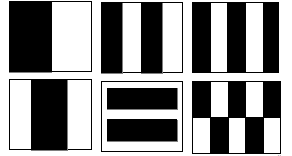How to read with baby? just read to them right? Yes mostly. And enjoy it.
-
But here’s some more information and tips on how to read with baby from the first few months onwards.
→ → → For the full story on reading, see the more detailed page here
Age 0-3 months (and 3-6 months)
-
Baby will love hearing the sound of your voice. They may recognise voices from the womb so it’s not too early to start reading to them
-
Baby’s eyes are developing still, obviously, but they can see stark, high contrasting colours and images, such as the ones below. I bought some high contrasting flash cards for the Little Lovely to look at, see more about that here, but you can easily make or download these. I knocked up a few below, available as a PDF.
-
Simple squares might be ones to start with. Print off and cut out. Stick onto card, make into a mobile, or just show on paper. Alternatively, make your own flash card book.
-
I bought a small baby board book from a charity shop (about 50p I think), and cut out and attached one image to each one of the pages. The high contrast images were covering the original book, but it was cheap and not that interesting so I didn’t mind. It was much simplier than trying to make my own board book from scratch!
⇒ Click link to download: High contrast images for baby – visual stimulation – simple square images
3-6 months
-
High contrast images might still be interesting for baby to look at
-
Reading early on with baby gets both you and them into good reading habits and pattern of behaviour – for example, a recent study found that reading with 4 month old children was related to shared book reading when the child was 8 months old – and reading at 8 months old was found to be related to language skills at 12 and 16 months, so earlier book reading promoted later book reading and skills
-
Read with expression – don’t forget about facial expression and mirroring baby’s expression also – babies are fascinated by faces.
-
Describe and name the pictures, describe what is happening – children’s books at this age might not have much text, but make the most out of the pictures. what’s going on? what are the colours? is there something relevant to your life and baby such as the little boy in the story likes a red car, and you have a toy red car? What sound does the car make? And so on.
6-12 months
-
Continue to read with expression, different voices, faces
-
Now that baby has more attention they can sit through a short story book
-
Now that baby has more control of their hands and increased motor skills – try some interactive and lift the flap books. At 9 months the Little Lovely is very curious (and was in the months before this) and likes interactive books where he can flip things back and forth, feel different textures and some books that also play sounds. He can’t always press all of the buttons hard enough to make the sound yet though.
-
Interactive books will help baby learn about cause and effect, and increase their sense of their own control and direction over their actions
-
-
As before, describe and name the pictures, describe what is happening – There might be more text in the story now than in 3-6 month old books. But still, make the most out of the pictures, link the text to the pictures, point and describe. What’s going on? what are the colours? is there something relevant to your life and baby?
-
What sound do things in the book make? Baby will be able to imitate some sounds now – they might love blowing raspberries, making certain sounds like dadada, bababa, mamama (at 9 months, LL likes to shout DADADA very loudly, can’t remember exactly when he started on the dada, maybe 7 or 8 months, followed by baba, then mama) – so can you link this to characters or things in the book so baby can learn more about the meanings of those words/sounds?
-
We attach meaning to words as guided by parents and those who teach us – e.g. “cat” just means a random collection of sounds unless we learn to associate it with what a cat is.
-
So, can you start to associate the sounds and words with what they actually mean and increase your baby’s understanding of these words?
-
References:
-
Lariviere & Rennick (2011). Parent picture-book reading to infants in the neonatal intensive care unit as an intervention supporting parent-infant interaction and later book reading. Journal of Developmental & Behavioral Pediatrics, 32 (2), pp 146-152.
-
Karras, J. & Braungart-Rieker, J. (2005). Effects of shared parent-infant book reading on early language acquisition. Applied Developmental Psychology, 26, 133-148.
-
Brémond-Gignac D., Copin H., Lapillonne A., Milazzo S. (2011). Visual development in infants: physiological and pathological mechanisms. Curr. Opin. Ophthalmol. 22, S1–S8.
-
Decasper AJ, Fifer WP. Of human bonding: newborns prefer their mothers’ voice. Science. 1980;208:1174 –1176.
Other references influencing this page:
-
High P, Lagasse L, Becker S, Algren L, Gardner A. Literacy promotion in primary care pediatrics: can we make a difference? Pediatrics. 2000;105:927–934.


Pingback: Newborn baby first week – schedule and our typical day | Baby Brain